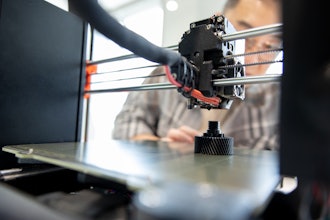FLASH MEMORY SUMMIT and THE INTERNATIONAL SYMPOSIUM ON LOW POWER ELECTRONICS AND DESIGN -- Lyric Semiconductor, Inc. (http://www.lyricsemiconductor.com/) a DARPA- and venture-funded MIT spin-out, today emerged from stealth mode to launch a new technology called probability processing, which is poised to deliver a fundamental change in processing performance and power consumption. With over a decade of development at MIT and at Lyric Semiconductor, Lyric's probability processing technology (http://www.lyricsemiconductor.com/technology.htm) calculates in a completely new way, enabling orders-of-magnitude improvement in processor efficiency. Lyric Error Correction (LEC) (http://www.lyricsemiconductor.com/products-cores.htm) for flash memory, the first commercial application of probability processing, offers a 30X reduction in die size and a 12X improvement in power consumption all at higher throughput compared to today's digital solutions.
Lyric Semiconductor has developed an alternative to digital computing. The company is redesigning processing circuits from the ground up to natively process probabilities -- from the gate circuits to the processor architecture to the programming language. As a result, many applications that today require a thousand conventional processors will soon run in just one Lyric processor, providing 1,000X efficiencies in cost, power, and size.
For over 60 years, computers have been based on digital computing principles. Data is represented as bits (1s and 0s). Boolean logic gates perform operations on these bits. Lyric has invented a new kind of logic gate circuit that uses transistors as dimmer switches instead of as on/off switches. These circuits can accept inputs and calculate outputs that are between 0 and 1, directly representing probabilities -- levels of certainty.
A digital processor steps through these operations serially in order to perform a function. In order to improve efficiency even further, Lyric's processors are designed to perform many probability computations in parallel.
Lyric's approach can accelerate search, fraud detection, spam filtering, financial modeling, genome sequence analysis, and many other important present and future applications that involve simultaneously considering many possible alternatives and deciding on the best fit -- the best guess for the answer. In theory, digital processors can perform these calculations, but in practice, they do so very inefficiently. As a result, a huge amount of processing overhead is required, costing an enormous amount of space, power and money.
"After a decade of development, we have no shortage of opportunities for our probability processing technology, but we are currently focused on a modest list of both short and long-term applications that will see enormous gains in performance," says Lyric Semiconductor CEO and co-founder Ben Vigoda (http://www.lyricsemiconductor.com/company-team.htm) . "We are starting with Lyric Error Correction but ultimately plan to develop a more general purpose probability processor that will truly change the landscape for many applications."
Lyric Error Correction (LEC) (http://www.lyricsemiconductor.com/products-cores.htm) for Flash Memory
Flash error rates have become increasingly problematic with each new generation of the technology. Today, one in every thousand bits stored in a flash memory comes out wrong when the memory is read. In the next generation, the number of errors will approach one bit wrong in every hundred. Flash companies spend billions of dollars on new foundry processes in order to increase overall flash density, but then suffer from increasing error rates. As a result, "advanced" error correctors have had to become significantly larger, more complex and more expensive. LEC is Lyric's first commercial probability processing offering -- an advanced error corrector for flash memories that is 30X smaller and has 12X lower power consumption, all at a higher bandwidth than the digital implementations currently available.
The GP5 (http://www.lyricsemiconductor.com/technology-processor.htm)
Beyond today's LEC technology, Lyric is developing the GP5 -- a general-purpose programmable probability processing platform. The GP5 will be ideally suited to calculate probabilities for all types of applications -- from web searches to genome sequencing -- and could enable performance gains of 1,000X over today's digital x86-based systems such as the processors from Intel and AMD. The GP5 will run code written in Lyric's own probability programming language called PSBL (Probability Synthesis to Bayesian Logic) (http://www.lyricsemiconductor.com/technology-programs.htm) , an expressive computer programming language for working with probability based computations. Lyric will leverage its probability processor and programming technologies to deliver disruptive total systems to its customers.
Availability
Lyric's LEC technology is currently available for license, accompanied by support services enabling product integration within 12 months. Beyond LEC, the first GP5 will begin sampling in 2013.
About Lyric Semiconductor
Lyric Semiconductor is a fabless semiconductor company founded in 2006 by MIT Ph.D. Ben Vigoda (http://www.lyricsemiconductor.com/company-team.htm) and semiconductor industry veteran David Reynolds (http://www.lyricsemiconductor.com/company-team.htm) , and is located in Cambridge, Mass. Lyric's probability processing technology was first envisioned by Vigoda at MIT. Lyric's lead investor and chairman of the board is Ray Stata, founder and 30-plus year CEO of Analog Devices and lead partner of Stata Venture Partners. Lyric currently employs 30 people and has received more than $20 million in government funding from DARPA and other agencies and venture investment from Stata Venture Partners. Lyric Semiconductor maintains a growing IP portfolio of 50 fundamental patent filings in the field of probability processing.
Executives from Lyric Semiconductor will be speaking at the Flash Memory Summit in the Santa Clara Convention Center, Santa Clara, Calif., and the International Symposium on Low Power Electronics and Design in Austin, Texas. CEO Ben Vigoda will be presenting at the Flash Memory Summit's exhibit hall theatre on Wednesday, August 18 at 12:45 p.m. Pacific, and as a panelist at Session 201, Error Correcting Codes, on Thursday, August 19 at 9:50 a.m. Pacific. Also on Thursday, Theophane Weber, Lyric research scientist, will present "Low Power Logic for Statistical Signal Processing," at Special Session One on energy-efficiency via error-resiliency at 3 p.m. Central at the Omni Hotel, Downtown Austin, Texas in Capital Ballroom A.
More information on the company and its probability processing technology can be found at its new web site, also launched today, at www.lyricsemiconductor.com (http://www.lyricsemiconductor.com) .
About Lyric Semiconductor, Inc.
Lyric Semiconductor is a fabless semiconductor company founded in 2006 by MIT Ph.D. Ben Vigoda and semiconductor industry veteran David Reynolds, and is located in Cambridge, Mass. Lyric's probability processing technology was first envisioned by Vigoda at MIT. Lyric's lead investor and chairman of the board is Ray Stata, founder and 30-plus year CEO of Analog Devices and lead partner of Stata Venture Partners. Lyric currently employs 30 people and has received more than $20 million in government funding from DARPA and other agencies and venture investment from Stata Venture Partners. Lyric Semiconductor maintains a growing IP portfolio of 50 fundamental patent filings in the field of probability processing.
Approved for Public Release, Distribution Unlimited. The views, opinions, and/or findings contained in this article/presentation are those of the author/presenter and should not be interpreted as representing the official views or policies, either expressed or implied, of the Defense Advanced Research Projects Agency or the Department of Defense.


















